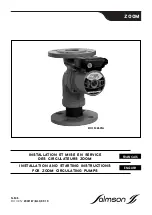
6
installation
&
operation
manual
|
ocle
/
ocla
heating
system
2.3
COOLANT PLUMBING
INSTALLATION
NOTICE
Heating system damage:
Engine vibration will
damage the heating system; isolate the heating system
from vibration. Never mount the heating system or
components directly to the engine. If the heating
system is installed using rigid pipe, use a section of
flexible hose to the supply and return ports to isolate
the heating system from engine vibration.
2.3.1 COOLANT SUPPLY
When installing the OCLE/OCLA coolant supply line,
refer to the following
HOTSTART
guidelines
(See
SECOIO 2.4
)
:
•
At a minimum, size the coolant supply line
per the pump inlet.
OOICE!
Do not reduce
the supply line inner diameter; pump seal
damage will occur.
OOE:
To maximize flow and allow the longest
possible supply line, install the largest
practical inner diameter hose; for most
installations,
HOTSTART
recommends using
a hose with a size larger inner diameter than
the pump inlet.
•
Install the coolant suction port as low as
possible on the engine’s water jacket. Where
applicable, HOTSTART recommends a
connection point at the suction side of the
engine water pump
(A)
.
OOICE!
At a
minimum, suction port must be sized per
the pump inlet (1.25" NPT).
•
To minimize flow restriction, the coolant
supply line must be as short and as straight
as possible. Use elbow fittings sparingly;
HOTSTART
recommends using sweeping
bends or 45° fittings.
OOE:
For optimal pump performance, HOTSTART
recommends a minimum of 6 inches
(152 mm) of straight pipe installed into
pump inlet.
2.3.2 COOLANT RETURN
When installing the OCLE/OCLA coolant return line, refer
to the following
HOTSTART
guidelines
( See
SECOIO
2.4
)
:
•
Size the coolant return line per the coolant
outlet.
OOICE!
Do not reduce the return
line inner diameter.
•
Install the coolant discharge port as high as
possible on the engine’s water jacket at the
end of the engine opposite the suction port,
typically at the rear of the engine block on the
engine water rails
(B)
.
2.3.3 COOLANT PRESSURE RELIEF
•
To safeguard personnel and equipment,
attach an appropriately-sized pipe to the
pressure relief valve and route to a safe
area, bucket or catch-basin.
CAUOIO !
Coolant pressure relief valve outlet must
be plumbed to a safe area in case an
over-pressure release of heated coolant
occurs. Do not connect pressure relief
plumbing to heating system or engine
coolant system.










































